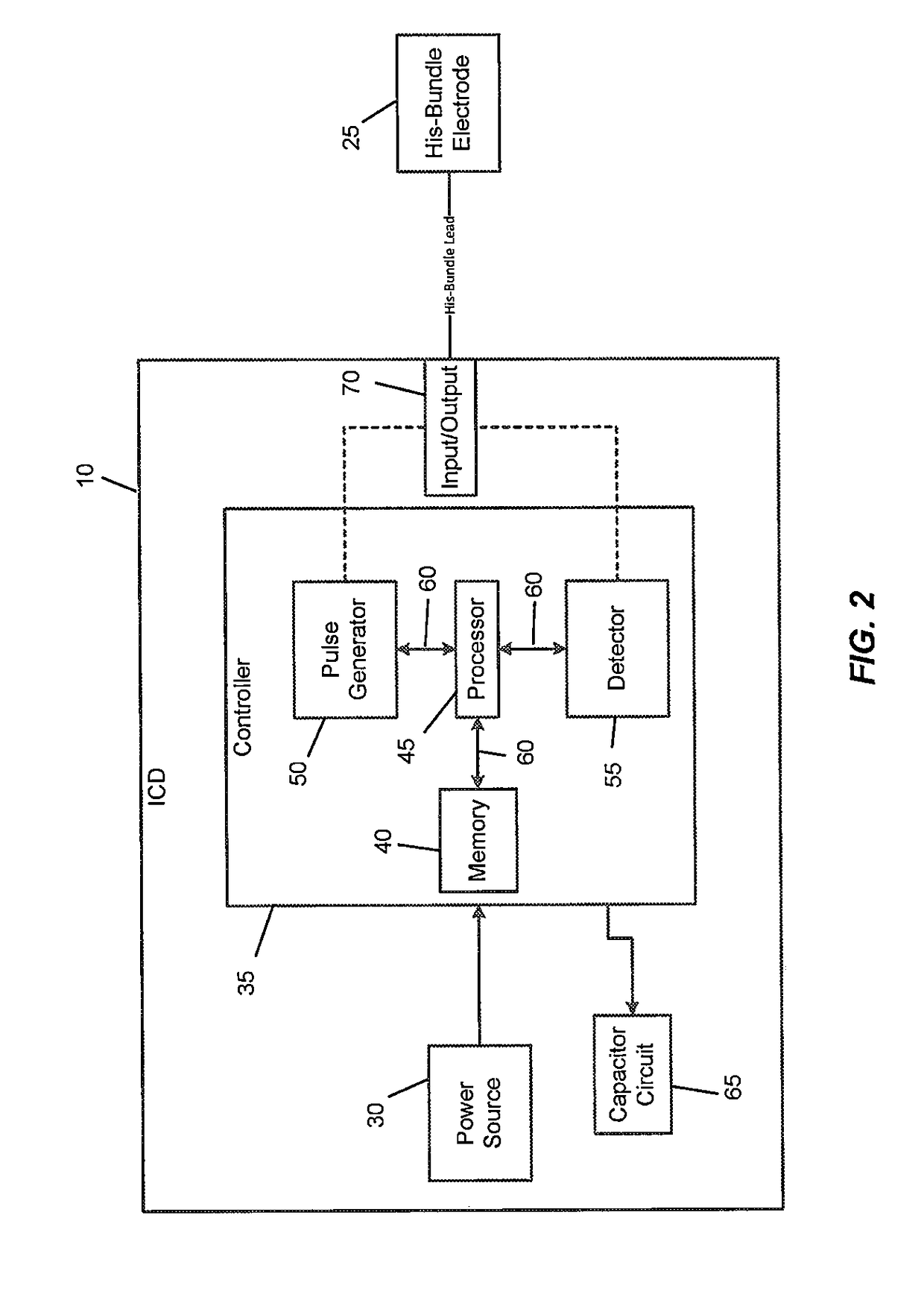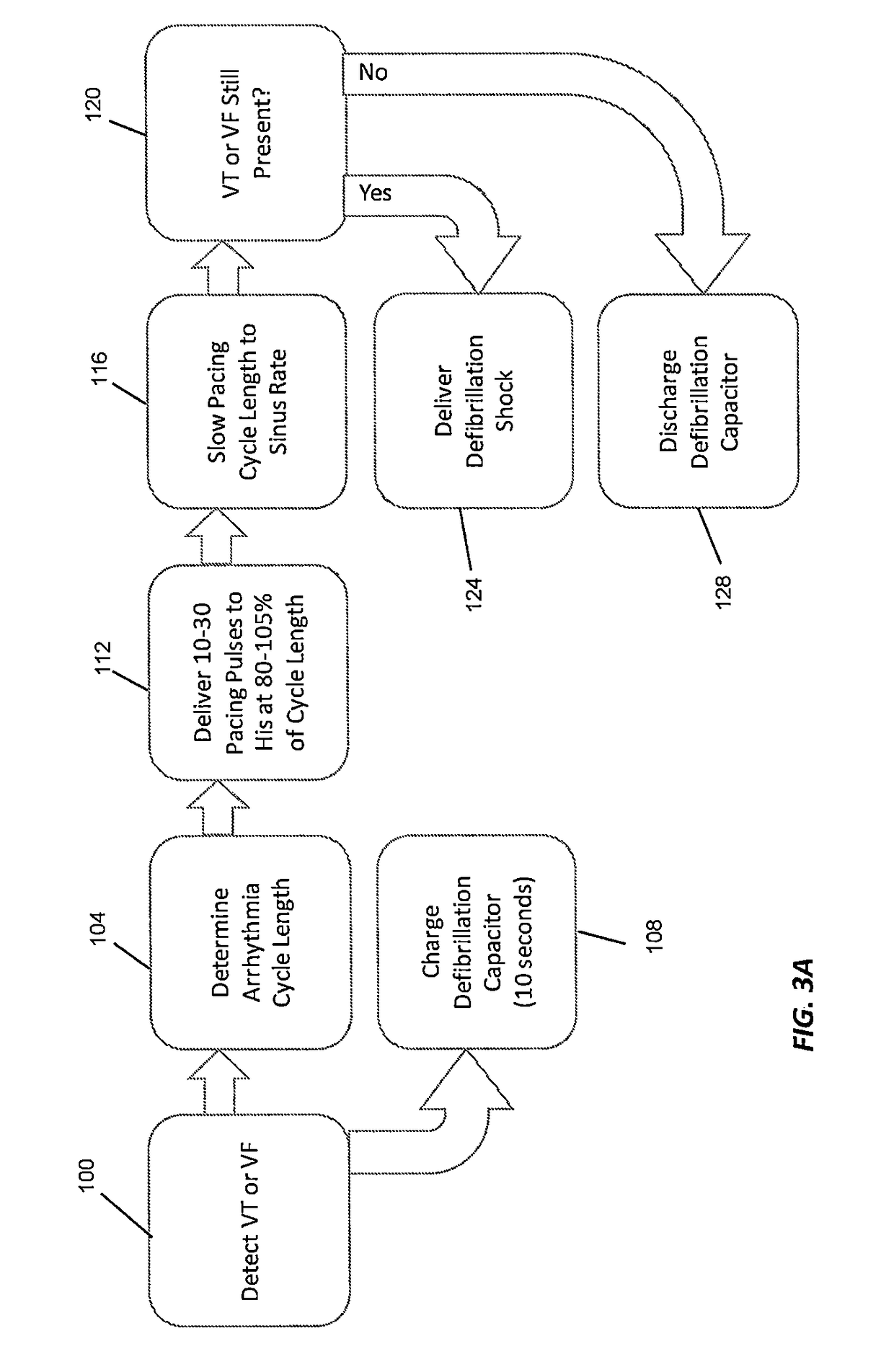Implantable cardiac devices and methods for delivering low energy, pain-free defibrillation signals for ventricular arrhythmias
a low energy, pain-free technology, applied in the direction of heart stimulators, heart defibrillators, therapy, etc., can solve the problems of defibrillation shock failure, shock failure, etc., and achieve the effect of reducing the inducibility of vf and prone to arrhythmogenesis
- Summary
- Abstract
- Description
- Claims
- Application Information
AI Technical Summary
Benefits of technology
Problems solved by technology
Method used
Image
Examples
example 1
nje System can Operate as a Pacing Distribution System During VF Such that Cardiac Activation May Spread Through the Conduction System and Capture Sufficient Cardiac Mass Such that VF Wavefronts are Halted
[0072]This approach has the potential to reduce DFTs to a series of pacing level amplitude shocks. This approach is fundamentally different from traditional defibrillation mechanisms. Effective defibrillation therapy has been based on the principle that large shocks not only directly stimulate tissue near the shocking electrodes, but that virtual electrode effects cause secondary sources at sites far from the shocking electrodes. Substantial reductions in defibrillation energy are unlikely to be achieved while the primary mechanism for defibrillation is the creation of secondary sources far from stimulating electrodes. Since this technique is based on local capture and spread of activation through the conduction system rather than creation of far field secondary sources, the stimul...
example 2
Pacing Parameters for Terminating VF Through Pacing of the His-Purkinje System
[0084]Multi-pulse defibrillation techniques that deliver stimuli near the VF cycle length rely on progressive capture of increasing amounts of tissue with a train of pulses. Low energy multi-pulse defibrillation techniques may be effective in large hearts if one or more of the following criteria are met: 1) pulses are of sufficient strength to cause virtual electrodes at sites distant from the stimulation electrodes, 2) pulses are delivered at strategic locations such that stable reentrant circuit sites are disrupted and the pacing pulses can dominate the activity of the heart, or 3) excitation pulses are distributed throughout much of the heart such that tissue captured adjacent to electrodes sums to a critical mass of the heart and extinguishes activity throughout the heart. Criteria 1 is utilized by clinically accepted defibrillation techniques. Very large shocks are almost always nearly successful in t...
example 3
for Delivering Low-Energy Pacing Trains to the Purkinje System During VF to Terminate Fibrillation
[0093]Direct pacing of the Purkinje system has proven difficult until recent improvements in steerable sheaths and catheters have become available. The Select Secure 3830 ventricular lead and the Select Site deflectable sheath (Medtronic, Inc.) is gaining acceptance as a feasible catheter for chronic His bundle pacing. While this approach has not been used for defibrillation, His bundle pacing has led to improved ventricular synchrony and cardiac output than patients with biventricular cardiac resynchronization therapy.
[0094]Algorithms for detection of tachycardia cycle lengths and ATP protocols are a standard feature in commercially available ICDs. Incorporation of multi-pulse or high frequency pulse trains to commercial devices likely will not require significant changes to hardware. The addition of a His-bundle lead to current ICDs may be accomplished by current CRT devices with a Hi...
PUM
 Login to View More
Login to View More Abstract
Description
Claims
Application Information
 Login to View More
Login to View More - R&D
- Intellectual Property
- Life Sciences
- Materials
- Tech Scout
- Unparalleled Data Quality
- Higher Quality Content
- 60% Fewer Hallucinations
Browse by: Latest US Patents, China's latest patents, Technical Efficacy Thesaurus, Application Domain, Technology Topic, Popular Technical Reports.
© 2025 PatSnap. All rights reserved.Legal|Privacy policy|Modern Slavery Act Transparency Statement|Sitemap|About US| Contact US: help@patsnap.com



